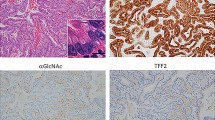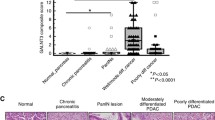Abstract
Gastric gland mucin secreted from pyloric gland cells, mucous neck cells, and cardiac gland cells of the gastric mucosa harbors unique O-glycans carrying terminal α1,4-linked N-acetylglucosamine residues (αGlcNAc), which are primarily attached to the scaffold mucin core protein MUC6. αGlcNAc acts as an antibiotic against Helicobacter pylori (H. pylori), a microbe causing gastric cancer. In addition, mice deficient in A4gnt, which encodes the enzyme α1,4-N-acetylglucosaminyltransferase (α4GnT) that catalyzes αGlcNAc biosynthesis, spontaneously develop gastric differentiated-type adenocarcinoma, even if not infected by H. pylori. Thus, αGlcNAc prevents gastric cancer as both an antibiotic and a tumor suppressor (Nakayama in Acta Histochem Cytochem 47:1–9, 2014b). Indeed, in humans αGlcNAc loss on MUC6 in differentiated-type adenocarcinoma is closely associated with poor patient prognosis (Shiratsu et al. in Cancer Sci 105:126–133, 2014). Recently, we reported reduced αGlcNAc expression on MUC6 in both pyloric gland adenoma of the stomach and chronic atrophic gastritis, in Barrett’s esophagus, and in pancreatic intraductal papillary-mucinous neoplasm (IPMN)/pancreatic intraepithelial neoplasia (PanIN), all potentially premalignant conditions. This review discusses whether relatively reduced levels of αGlcNAc in these lesions could serve as a biomarker to predict malignant potential and cancer progression.

[b is From Nakayama (2014b); Copyright 2014 The Japanese Society of Histochemistry and Cytochemistry]

[From Yamanoi et al. (2015b); Copyright 2015 John Wiley & Sons Ltd.]

[From Yamada et al. (2015); Copyright 2015 Journal of Gastroenterology and Hepatology Foundation and Wiley Publishing Asia Pty Ltd.]

[From Iwaya et al. (2014) with modification; Copyright 2014 John Wiley & Sons Ltd.]

[From Ohya et al. (2017) with modification]
Similar content being viewed by others
References
Basturk O, Hong SM, Wood LD, Adsay NV, Albores-Saavedra J, Biankin AV, Brosens LA, Fukushima N, Goggins M, Hruban RH, Kato Y, Klimstra DS, Klöppel G, Krasinskas A, Longnecker DS, Matthaei H, Offerhaus GJ, Shimizu M, Takaori K, Terris B, Yachida S, Esposito I, Furukawa T (2015) A revised classification system and recommendations from the Baltimore consensus meeting for neoplastic precursors lesions in the pancreas. Am J Surg Pathol 39:1730–1741
Chen ZM, Scudiere JR, Abraham SC, Montgomery E (2009) Pyloric gland adenoma: an entity distinct from gastric foveolar type adenoma. Am J Surg Pathol 33:186–193
Ferreira B, Marcos NT, David L, Nakayama J, Reis CA (2006) Terminal α1,4-linked N-acetylglucosamine in Helicobacter pylori-associated intestinal metaplasia of the human stomach and gastric carcinoma cell lines. J Histochem Cytochem 54:585–591
Frederik HJ, Lars P, Asbjørn MD, Henrik TS, Peter FJ (2011) Incidence of adenocarcinoma among patients with Barrett’s esophagus. N Eng J Med 365:1375–1383
Furukawa T, Kuboki Y, Tanji E, Yoshida S, Hatori T, Yamamoto M, Shibata N, Shimizu K, Kamatani N, Shiratori K (2011) Whole-exome sequencing uncovers frequent GNAS mutations in intraductal papillary mucinous neoplasms of the pancreas. Sci Rep 1:161–167
Ishihara K, Kurihara M, Goso Y, Urata T, Ota H, Katsuyama T, Hotta K (1996) Peripheral α-linked N-acetylglucosamine on the carbohydrate moiety of mucin derived from mammalian gastric gland mucous cells: epitope recognized by a newly characterized monoclonal antibody. Biochem J 318(Pt 2):409–416
Iwaya Y, Hasebe O, Koide N, Kitahara K, Suga T, Shinji A, Muraki T, Yokosawa S, Yamada S, Arakura N, Tanaka E, Nakayama J (2014) Reduced expression of αGlcNAc in Barrett’s oesophagus adjacent to Barrett’s adenocarcinoma—a possible biomarker to predict the malignant potential of Barrett’s oesophagus. Histopathology 64:536–546
Janmaat VT, van Olphen SH, Biermann KE, Looijenga LHJ, Bruno MB, Spaander MCW (2017) Use of immunohistochemical biomarkers as independent predictor of neoplastic progression in Barrett’s oesophagus surveillance: a systematic review and meta-analysis. PLoS One 12:e0186305
Karasawa F, Shiota A, Goso Y, Kobayashi M, Sato Y, Masumoto J, Fujiwara M, Yokosawa S, Muraki T, Miyagawa S, Ueda M, Fukuda MN, Fukuda M, Ishihara K, Nakayama J (2012) Essential role of gastric gland mucin in preventing gastric cancer in mice. J Clin Invest 122:923–934
Kawakubo M, Ito Y, Okimura Y, Kobayashi M, Sakura K, Kasama S, Fukuda M, Katsuyama T, Nakayama J (2004) Natural antibiotic function of a human gastric mucin against Helicobacter pylori infection. Science 305:1003–1006
Kobayashi M, Fujinaga Y, Ota H (2014) Reappraisal of the immunophenotype of pancreatic intraductal papillary mucinous neoplasms (IPMNs)—gastric pyloric and small intestinal immunophenotype expression in gastric and intestinal type IPMNs—. Acta Histochem Cytochem 47:45–57
Kushima R, Vieth M, Borchard F, Stolte M, Mukaisho K, Hattori T (2006) Gastric-type well-differentiated adenocarcinoma and pyloric gland adenoma of the stomach. Gastric Cancer 9:177–184
Maekita T, Nakazawa K, Mihara M, Nakajima T, Yanaoka K, Iguchi M, Arii K, Kaneda A, Tsukamoto T, Tatematsu M, Tamura G, Saito D, Sugimura T, Ichinose M, Ushijima T (2006) High levels of aberrant DNA methylation in Helicobacter pylori-infected gastric mucosae and its possible association with gastric cancer risk. Clin Cancer Res 12:989–995
Matsubara A, Sekine S, Kushima R, Ogawa R, Taniguchi H, Tsuda H, Kanai Y (2013) Frequent GNAS and KRAS mutations in pyloric gland adenoma of the stomach and duodenum. J Pathol 229:579–587
Matsuzawa K, Akamatsu T, Katsuyama T (1992) Mucin histochemistry of pancreatic duct cell carcinoma, with special reference to organoid differentiation simulating gastric pyloric mucosa. Hum Pathol 23:925–933
Matthaei H, Wu J, Dal Molin M, Shi C, Perner S, Kristiansen G, Lingohr P, Kalff JC, Wolfgang CL, Kinzler KW, Vogelstein B, Maitra A, Hruban RH (2014) GNAS sequencing identifies IPMN-specific mutations in a subgroup of diminutive pancreatic cysts referred to as “incipient IPMNs”. Am J Surg Pathol 38:360–363
Morris A, Nicholson G (1987) Ingestion of Campylobacter pyloridis causes gastritis and raised fasting gastric pH. Am J Gastroenterol 82:192–199
Nakayama J (2014a) Alpha-1,4-N-acetylglucosaminyltransferase (A4GNT). In: Taniguchi N, Honke K, Fukuda M, Narimatsu H, Yamaguchi Y, Angata T (eds) Handbook of glycosyltransferases and related genes, 2nd edn. Springer, Japan, Tokyo, pp 379–391
Nakayama J (2014b) Dual roles of gastric gland mucin-specific O-glycans in prevention of gastric cancer. Acta Histochem Cytochem 47:1–9
Nakayama J, Yeh J-C, Misra A, Ito S, Katsuyama T, Fukuda M (1999) Expression cloning of a human α1,4-N-acetylglucosaminyltransferase that forms GlcNAcα1→4GalβR, a glycan specifically expressed in the gastric gland mucous cell type mucin. Proc Natl Acad Sci USA 96:8991–8996
Ohya A, Yamanoi K, Shimojo H, Fujii C, Nakayama J (2017) Gastric gland mucin-specific O-glycan expression decreases with tumor progression from precursor lesions to pancreatic cancer. Cancer Sci 108:1897–1902
Ota H, Katsuyama T (1992) Alterning laminated array of two types of mucin in the human gastric surface mucous layer. Histochem J 24:86–92
Ota H, Katsuyama T, Ishii K, Nakayama J, Shiozawa T, Tsukahara Y (1991) A dual staining method for identifying mucins of different gastric epithelial mucous cells. Histochem J 23:22–28
Reid BJ, Blount PL, Rubin CE, Levine DS, Haggitt RC, Rabinovitch PS (1992) Flow-cytometric and histological progression to malignancy in Barrett’s esophagus: prospective endoscopic surveillance of a cohort. Gastroenterology 102:1212–1219
Shiratsu K, Higuchi K, Nakayama J (2014) Loss of gastric gland mucin-specific O-glycan is associated with progression of differentiated-type adenocarcinoma of the stomach. Cancer Sci 105:126–133
Vieth M, Kushima R, Borchard F, Stolte M (2003) Pyloric gland adenoma: a clinico-pathological analysis of 90 cases. Virchows Arch 442:317–321
Wang KK, Samliner RE (2008) Updated guidelines 2008 for the diagnosis, surveillance and therapy of Barrett’s esophagus. Am J Gastroenterol 103:788–797
Yamada S, Okamura T, Kobayashi S, Tanaka E, Nakayama J (2015) Reduced gland mucin-specific O-glycan in gastric atrophy: a possible risk factor for differentiated-type adenocarcinoma of the stomach. J Gastroenterol Hepatol 30:1478–1484
Yamanoi K, Arai E, Tian Y, Takahashi Y, Miyata S, Sasaki H, Chiwaki F, Ichikawa H, Sakamoto H, Kushima R, Katai H, Yoshida T, Sakamoto M, Kanai Y (2015a) Epigenetic clustering of gastric carcinomas based on DNA methylation profiles at the precancerous stage: its correlation with tumor aggressiveness and patient outcome. Carcinogenesis 36:509–520
Yamanoi K, Sekine S, Higuchi K, Kushima R, Nakayama J (2015b) Decreased expression of gastric gland mucin-specific glycan α1,4-linked N-acetylglucosamine on its scaffold mucin 6 is associated with malignant potential of pyloric gland adenoma of the stomach. Histopathology 67:898–904
Zhang MX, Nakayama J, Hidaka E, Kubota S, Yan J, Ota H, Fukuda M (2001) Immunohistochemical demonstration of α1,4-N-acetylglucosaminyltransferase that forms GlcNAcα1,4Galβ residues in human gastrointestinal mucosa. J Histochem Cytochem 49:587–596
Acknowledgements
The authors are grateful to all collaborators for their contribution to research relevant to the gastric gland mucin-specific O-glycan αGlcNAc. The authors also thank Dr. Elise Lamar for editing the manuscript.
Funding
Grants-in-Aid for Scientific Research 15H04712 and 17K15640 from the Japan Society for the Promotion of Science.
Author information
Authors and Affiliations
Corresponding author
Ethics declarations
Conflict of interest
The authors declare that they have no conflict of interest in association with the present study.
Rights and permissions
About this article
Cite this article
Yamanoi, K., Nakayama, J. Reduced αGlcNAc glycosylation on gastric gland mucin is a biomarker of malignant potential for gastric cancer, Barrett’s adenocarcinoma, and pancreatic cancer. Histochem Cell Biol 149, 569–575 (2018). https://doi.org/10.1007/s00418-018-1667-8
Accepted:
Published:
Issue Date:
DOI: https://doi.org/10.1007/s00418-018-1667-8




